BAFA © 2010. All material here is copyrighted. See conditions above. |
Maxim Dumitras
sculptor, painter, performance, curator, and museum director, Romania
|
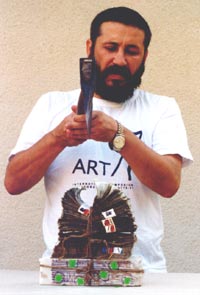
Maxim Dumitras, 1997. 
In this performance he cut a pile of money in half at the CarbonART symposium in 1997. And it was his response to the
theme of getting in touch with nature. This act shows that money has no soul, it was cut in half and left to float on a river to be absorbed by nature.
|
Translated by Cordos Tudor,
in conversation with Sonja van Kerkhoff, 2002
Growing up on a farm in the small mountain town of Singeorz-Bai in northern Romania, Maxim remembers making simple objects carved out of soft wood from the age of 6. His grandfather had a sharp knife that he only used for shaving for church each Sunday. During the week Maxim used the tip of this knife for carving. On Sunday the tip would be blunt, so for several years, his grandfather rose early to sharpen the knife each Sunday, never realising that Maxim was the cause.
He is very grateful to his parents who were very supportive of his art. When he was 13 (in 1971) he was apprenticed to a sculptor in Cluj (the cultural capital of Transylvania, about 100 km from Singeorz-Bai) who taught him drawing, carving and painting for four years. His parents bought him tools and also paid the sculptor (by selling a steer each year).
Later he went to study at art school in Bucharest for 2 years, graduating in 1989 and specialising in sculpture in wood and bronze. After this he isolated himself in his studio back in his hometown for the next 10 years, because under communism he couldn’t exhibit any work.
The only art that could be exhibited was social realist work praising the communist system. He worked actively for those ten years making sculpture and paintings and had contact with 3 or 4 artists exchanging ideas and sometimes working together in the mountains, living rough.
|
But generally he worked in isolation, as did many artists in those years.
To support himself he started working as a curator for the local ethnographic museum in 1979. The museum of folklore and traditional objects was started in 1976 by a local who had been collecting these objects, with the help of a supportive mayor who found the building and arranged funding through the local cultural centre. For a town this small (pop. 10,000) it is unusual to have such a museum.
This job gave Maxim the freedom to continue with his work but he also did, and still does, commissions of furniture, tombstones and interior design to supplement his income and support his family. His wife also works fulltime, and they have two children.
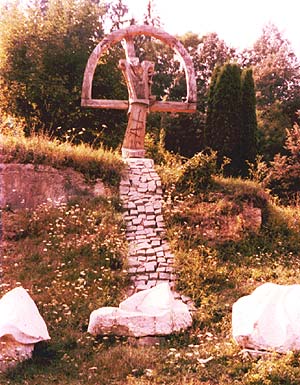
The nest of dreams, 1984, consists of three marble seat forms, shaped like mountains or cloaks, at the start of a path of small square granite forms that leads up to a totem-like human form in wood, symbollizing Christ as much as a guardian of the land. The intention is that the work will return to nature: 17 years later only the vertical human form is still intact, along with the stone elements. Once the wooden parts completely decompose, he will add a new contemporary form. Symbollically the mountains and the path remain, and the human or spiritual element is re-incarnated. The work is near the central park in the town.
|
 
Self-portrait, carved and arranged traditional wooden roofing, c. 2 metres high, 1984.
The window-like space in the middle symbolizes the soul and the sticks intersecting this space represent limitations and evils, such as the communist system. Under this the carved grooves symbolize water flowing out and the shape beside it symbolizes the creative hand.
So this work is a self-portrait of an artist under communism, facing limitations, and of the ability of the creative soul to find a means for expression.
His first exhibition was in 1991 in Laussane, Switzerland, as the result of a twin-city exchange, and there he came into contact with contemporary art, such as Bill Voila’s video work.
It was like a breakthrough because, by selling most of his paintings, he was able to travel to see a lot of exhibitions and make contact with
people who started to send him art magazines and catalogues.
He feels it is important to stay in contact with what is going on in the art world - otherwise you can end up making work that has already been done or is out of date. He wants to be open to new ideas to learn and to be inspired, and so in turn make work that relates to a wider audience.
|
Currently he participates in about three art symposia a year in Romania and usually one outside the country. These are usually sculpture symposia and are valuable opportunities to exchange ideas and others work.
Although he continues living in the same small town, now he isn’t so isolated.
He is also very active in the affairs of the town as the director of the musem since 1993 and also in organizing the summer arts symposium, which was held for the 14th time this summer (2002).
|

Threshold, 1993, carved stone, 1993, was a monument for the town of Chintelnic to commemorate a poet born there. It is a modernist abstract form in which crosses are carved. 5000 people came from the villages around to the opening, which was blessed by the Orthodox bishop. Maxim, in black, is standing between the bishop and a priest.
|

Habitation, stone, 1994. Made in memory of the heroes of World War I and II for the town of Oarba de Mures. Maxim is on the right.
|

The Family, painted wood made in 2002 at a symposium at an outdoor ethnographic museum. The forms symbolize the unity of the family and the white and blue are traditional colours for that region.
|
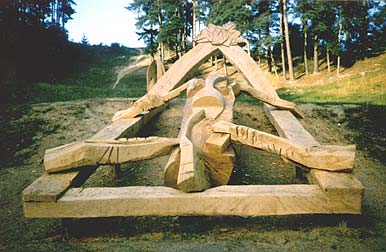
Descent of The Tomb, wood, 1992 made at the sculpture symposium in Singeorz-Bai in memory of a friend who was a philosopher.
|
His museum salary (which like most jobs in Romania is not enough to live on for a family) is from the regional museum institute and while he must account for his activities and make applications and budget, he has some freedom in the running of the museum.
Part of the freedom is achieved through the sponsoring that he finds from businesses in the town.
A sculpture teacher at the art school in Cluj organized the first Singeorz-Bai summer art symposium, in 1974.
|
He chose this town for a number of reasons.
It has a marble quarry, the mayor was very supportive of the arts, and being a tourist resort there was the potential for an appreciative audience.
During those communist years the town was so popular that the enormous hotels were overful, and it is still a popular holiday resort today.
The medicinal springs and mountain air attract people from the cities.
Maxim is anticipating that this audience will also be appreciative of the new museum and will support it.
The new 3 floor building should be finished in 2003.
The ground floor will focus on showing links between ethnographic objects and contemporary art, for instance by placing a 250-year-old carved gate beside an experimental contemporary work with a similar motif or form or by an artist inspired by this style of traditional carving.
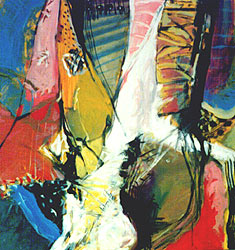
|
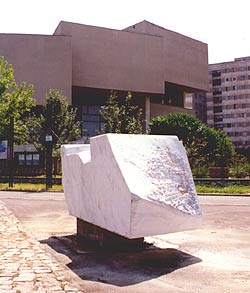
The Bridge, marble, 1998,
commission in Resita, Romania.
Maxim placed this close to a resturant and a walkway so people would come into close contact with it. He wanted it to be like a living bridge. Often glasses are left on it, after people have used it as a bar or table.
Left: Sacrifice, oil on canvas, 1994.
One of a series of four images.
|
The 2nd floor will focus on performance and contemporary art, and the attic will function as a library, reading room and archive, where work can also be viewed on video and computer.
Maxim is in contact with a museum near Geneva, from which he plans to borrow work by artists such as Miro, Degas, Picasso, and Giacommetti, etc, for touring exhibitions.
The works from the summer symposia have meant that the museum has about 250 sculptures and 400 paintings, in addition to an extensive
ethnographic collection, enough for constantly changing exhibitions. In his mind the whole museum is a performance in which each art work plays a part.
It is only the last few years that he has been so involved in organizing these symposia. Over the years, the symposia have focused successively on marble, wood, graphics or painting. Each lasts for about two weeks. The invited artists live and work in the town and leave a work for the museum collection. Generally only one or two of the artists
have come from outside Romania. In the early years 15 to 20 artists came each time.
|
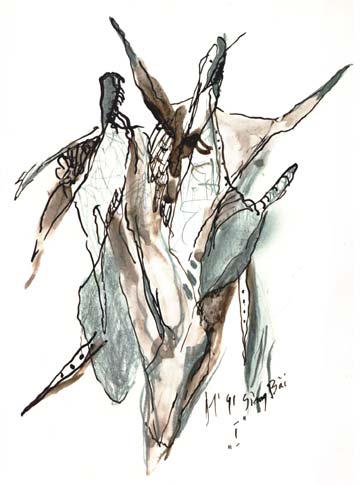
Character
, 1991
sepia and crayon on paper by Maxim Dumatris.
|
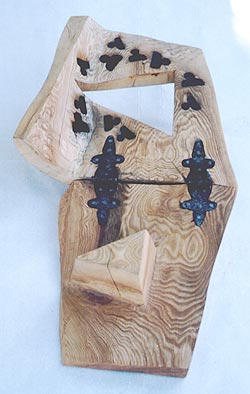
Detail of one of the forms in
Habitation of the Unicorn.
The same form is arranged 'standing'
in the photograph on the right.
|
Two years ago Maxim finished extending his studio so that he can now accommodate 7 to 8 artists on site, and since then he has only invited this number to each symposium.
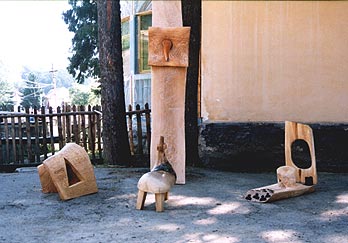
His Habitation of the Unicorn, made during a 1995 summer symposium, consists of 3 wooden objects worked with metal, and with metal elements inserted into the wooden forms. Two of these are hinged to be opened out like books and can be arranged in various ways. One has a triangular form, referring to the Christian trinity, and the other has a round form, suggestive of the unicorn’s cut-off horn. The totem-like form has a unicorn-like horn projecting out of it, and the small 4-legged animal-like form has a cross for a head. This form is inspired by old Romanian carvings.
|
However most of his creative energy goes into his own work, which can be anything from performance to sculpture, painting, ceramics, or land art. Anything in fact!
Wood is the material that has always been at hand. As an only child he spent hours cutting and stacking the firewood for their hard winters. Out of boredom he created arrangements, so as an adult he was reliving a childhood occupation in making a number of works out of stacked firewood in the town park - some igloo-like, others like a huge giant or gateways, and some in the context of a performance or action.
|
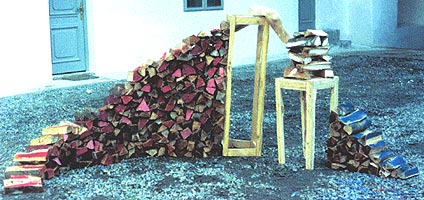
The Connection. One element of “The Path of the Tree” performance-sculpture, 1996. At a symposium in Tg. Mures for Eastern European artists working with sculpture, paintings, video and performance works. Maxim started with a mound of wood that was about 150 metres from the museum. Each day he created a composition with the wood, starting at the mound, and working with the theme of sacrifice and dialogue. On the following day he dismantled this to create another installation slightly closer to the museum. He continued this action of assembling and dismantelling until the work reached inside the museum. The title for the whole piece, “The Path of the Tree” in Romanian also refers to the saying, “wooden tongue”, meaning lots of talk with no content.
|
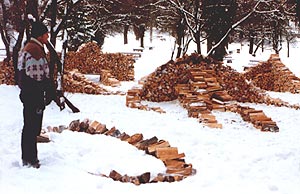
Overview of some stacked wood arrangements by Maxim Dumitras in the Singeorz-Bai town park in winter.
|
"The Utopia of Splendour" was a performance-land art piece made in Chisinau (Republic of Moldova) during CarbonART in 1997. About 20 artists from Romania, The Ukraine and Moldova worked in a forest, mainly on performance or land art. Some used neon in combination with natural materials, others dressed trees, others made clay huts or forms, one work incorporated oxen and a cart and the color blue. Another work, "The Pioneer" involved a man wrapped in paper unrolling an enormous wheel of paper into the forest.
Here Maxim sculpted first a 40-metre spiral and then a female form with hay.
|
Around this he arranged cane, wood stumps and stacked pieces of cut wood in a circle. Then Maxim created vertical assemblages of wood in the four directions around the circle. For the opening he laid photographs on the twenty or so tree stumps around this. Finally he removed them leaving the imprint of the larger circle surrounded by the four circles in the grass. It took him one month with 5 assistants to work on this enormous land work.
Another example of performance and sculpture is the 1994, "The Habitation of Cuckoos", a cycle of work he has been working with for many years.
As a child his parents paid him with a ceramic cuckoo for tending the sheep, which was as exciting for him as a hi-tech toy would be for a child today. So the ceramic cuckoo, a Romanian folk object, is a close childhood memory.
This particular work is a combination of performance and sculpture and finally was worked into the 1998 twenty minute video, "The Garments, The Dwelling, and The Cuckoos", which was broadcast (in Romanian) on national television. In 2001 this video represented Romania in Hannover in an international exhibition. It was projected on a wall for a month.
|

Detail of a Habitation sculpture showing the traditional Romanian ceramic cuckoos, woven cane and wood, adobe mud and pigment.
|

The Garments, The Dwelling, The Cuckoos in process. Men of his village wore these cane forms woven by Maxim, down the streets on his village. Later he added mud and painted these 'habitations'.
|
The video combines text and music, with details of sculpture, various arrangements of the ceramic birds and of footage from a performance of 6 village men ‘wearing’ his half-finished human-sized beehive-like woven cane forms. They were literally half-finished sculptures but also half-finished in the sense that these were like clothing without a spirit yet. So the men who wore these “garments” were giving something of their spirit, which inspired Maxim when reworking them with mud, paint and other objects. |
During the performance of the men walking down the street, hidden inside, they chatted to people they met who didn’t know who they were (in one case a wife): chatting with bird-like banter, and yet hidden, unfamiliar and unknown.
Maxim was inside the largest form on his knees, and at one point remained still on the street until people walked up to the form out of curiosity. Then when he moved they ran away. He was interested in how people reacted seeing the different forms, and found that they showed more fear of the more abstract forms than the more familiar rounded ones. Another aspect that he found very interesting was hearing the comments of people who were unaware of his presence, and he incorporated these comments in later works.
He came across some old woven and clay beehives in 1986 as part of his work for the ethnographic museum and loved the idea that these hives were the location or habitation for an unconventional structure of organization and activity. At the same time he is conscious of the irony in his work - referring to a cuckoo that lays eggs in other birds’ nests, and to a hive form that conceals the complex system within. So in another sense these forms are as much about the articificality of habitation and clothing as they are about symbolizing them. His vivid colours, in part, a reference to the bright colours used in folk art, emphasize this sense of artifice. |
 The Garments, The Dwelling, The Cuckoos objects, 1994, woven cane and wood, adobe mud and pigment.
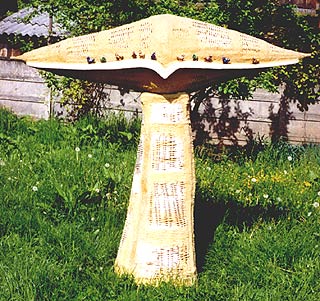 Habitation Habitation, 1994, woven cane and wood, adobe mud and pigment.
This "Habitation" is an example of one of his more light-hearted works. It has a mouth lined with ceramic cuckoos. One reading is that all human sound is replaced by cuckoo sounds, and another is that like the tower of Babel all human language becomes meaningless.
|
He has also made a number of paintings and sculpture incorporating these ceramic cuckoo forms. Often in patterns using the cuckoos as elements on 2-D and 3-D objects to refer to differing traditions.
One painting has about 20 of cuckoos arranged in concentric circles in the corner of a sheet of framed white perpex. From a distance it looks like a geometric abstract painting. Closer, and you see that each element is a ceramic bird and that in each circle the birds face a different direction, to mimick a folkdance in the neighbouring province of Moldavia. In another, a triangular arrangement of these birds refers to the pine tree, which is planted here when a young unmarried man dies. He is also planning to develop these works further into a video using dance and ritual footage.
| 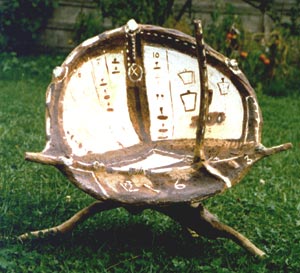
Habitation, 1994, woven cane and wood, adobe mud and pigment.
|
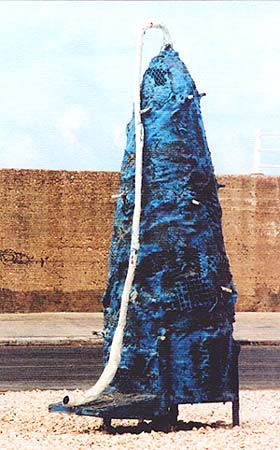
Garment, painted metal, 2002, about 3 metres high. This was made for "Artuborg 2002" in Constanta. Bucharest sculptor, Marius Leonte invited six other sculptors to make proposals which the architect Redin Tanior Abduraman worked into a seaside location at a city roundabout. The architect suggested the size for the works and then together with
assistants the seven huge sculptures were constructed.
| A lot of his work appears to be visually informed by contemporary art. When he starts talking, it is fascinating to hear just how much is infused with Romanian traditions.
Another plan incorporating these ceramic cuckoos is for an exhibition in Burcharest, where he will install about 50,000 of these, which are being made in differing colors relating to the provinces of Romania. They will be set into a hole or recess in the form of the original map of Romania before areas were taken in the past 80 years. They are being made by everyone in a village which is famous for making these cuckoos. Having a whole village make this work for display in the capital thousands of kilometres away is also a reminder of how a cosmospolition city such as Buracherest has lost the memory of tradition. The space will be covered in these cuckoos so people cannot enter the room. Music inspired by cuckoo sounds will be part of the installation. Finally he wants to fill each cuckoo with water (so that they produce a watery bird-sound when blown into) and distribute all 50,000 to the children of the city, so they disperse these icons of tradition into the streets and into their homes.
This work, like most of his work, while primarily inspired by his rural traditional culture and his contact with nature, carries political undertones. The map is a hint to the countries surrounding Romania and to the citizens, not to let any more of Romania be lost, not only physically but also pyschologically. Yet, ironcially, a cuckoo is a bird without a home. It survives by being mobile and looking for the opportunity to lay its eggs in another’s nest.
Maxim sees himself as an artist in this way. He takes what he can and then lays |
 this artwork with many free associations in another context - usually with a sense of sensuality - the tactile, often with humour and with a touch of social commentary. this artwork with many free associations in another context - usually with a sense of sensuality - the tactile, often with humour and with a touch of social commentary.
|
Most of his earlier sculpture was huge and heavy, in either marble, wood or metal, so making this series of cane works was also an experiment in working in a material that was both monumental and easy to manouver.
Another work,"Habitation for the spirit (see image on the right) is more bell-like in shape. You constantly hear the bells of the churches in this village. However Maxim said that the gong is like a soul - constantly in motion, making a noise and affecting the environment around. So in this sense the form is a garment for a moving & audible presence.
|
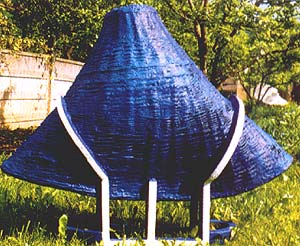
|
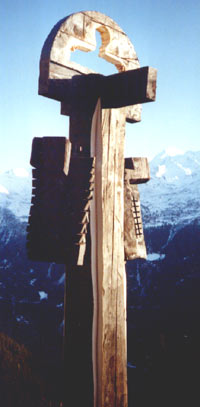
Day and Night 1996, commissioned in Laussance, the four sides refer to the four directions (north, south, etc), and the two gates hanging on each side of the human form move in the wind.
|
Some of Maxim's work relates directly to ecological issues, such as "The silence of water," made during an international symposium on the theme of "Peace for the Danube" in Turunu-Severin (southern Romania) in 2001. He made three huge fishtail forms and inserted texts about conserving and caring for the river on pieces of paper placed inside plastic tube in the tails. During an action the forms floated out in the Danube River, leaving a trail of ecological messages floating through Hungary towards Germany.
Maxim constantly works on a number of projects simutaneously: his sculptures, painting, a project in a nearby forest where he wants artists to shape or intervene on the growing trees, as well as his work in coordinating the building and development of the town museum. He is also a student in design at the university of Cluj, studying ceramics, where he is in the same class as his son. Many of his teachers were previously his students!
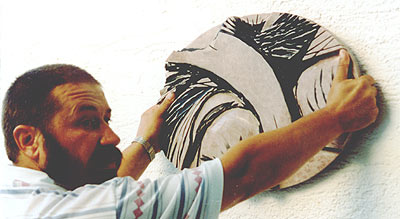
Maxim Dumitras with Icarus a relief carved in Irish Red Limestone for a collector in Munich, Germany, 2001.
|
Excerpts from pages 9 - 11, Arts Dialogue, November 2002.
. . . . . . . . . . . . . . . . . . . . . . . . . . . .
Maxim Dumitras is happy to have contact with other artists or curators
and can be contacted (preferably in French or Romanian) at:
Muzeul De Arta Comparat, Str. Republicii 58, 4529, Sangeorz-Bai, Romania.
Email: dumax -AT- k.ro
|
- Illustration and caption: Just Let the Wind, 2006
- Artist Profile, Arts Dialogue, November 2002
|

Arts Dialogue, Dintel 20, NL 7333 MC, Apeldoorn, The Netherlands
email: bafa@bahai-library.com
|
|





















 this artwork with many free associations in another context - usually with a sense of sensuality - the tactile, often with humour and with a touch of social commentary.
this artwork with many free associations in another context - usually with a sense of sensuality - the tactile, often with humour and with a touch of social commentary.

